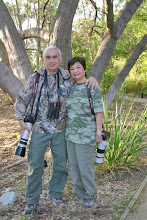It was an incredible experience we had at the Jelai Hotel parking lot that morning. Noon we decided to have lunch at the Food Court. That sounded quite simple, didn't it? Fact is, that food court was about half a kilometer from our hotel through a winding, undulating road. Rather daunting for people our age. To make things easy for us, we thought it would be a good idea to check out the hill station environments for birds. I even brought along our lighter gear, just in case, you know, we encounter an interesting bird along the way.
First we stopped by the Interpretive Bird Center which was some sort of a museum (with, thankfully, no stuffed specimens, but rather sculpted shapes of local birds). From there we passed the first curve of the road. To one side was a ravine overlooking the golf course and on the other a "wall" covered with thick vegetation, mostly ferns, with tall trees at the top. All of a sudden Cynthia stopped and looked at the ferns. I can tell her sharp ears heard something. Then even half-deaf me heard something too. There was some movement behind the fern leaves until out popped a noisy Mountain Bulbul. One more lifer to add to our list.
As we approached the long flight of stone steps towards the Food Court, we met a Japanese couple. The lady, obviously the birder of the two, was pointing at something halfway between the road and the hilltop. "Yellow bird", she said excitedly. I looked and saw a yellow bird called Grey Wagtail. It was interesting that the lady was thrilled to see such species whereas it would have been just a so-so bird for us.
Our lunch of Malaysian fare was forgettable. After lunch we further explored the road from the hill which had trees on both sides. It was here that we saw an unexpected lifer. I didn't know what it was until we got back to the hotel and I was able to access the internet. It was a White-browed Shrike-Babbler enjoying a caterpillar.
Not far from it was the poor bird of Fraser Hill. We call it poor because no one paid attention to it. Now don't get me wrong, this was not a tiny nondescript bird but rather a medium sized, dark blue colored beauty. When I first saw it at Jelai that morning, I shouted "Niltava! Niltava!" and eagerly took its picture. To my surprise not one of the 10 people in our group responded to my yelling. It felt like I was pointing to a Yellow-vented Bulbul to a bunch of Filipino birders.
Back at the fern-laden roadside. This time we were rewarded by a male Little Pied Flycatcher busily hawking for insects and a Mountain Fulvetta characteristically moving non-stop in search for food.
Passing by the area where we saw the wagtail, an Oriental Magpie Robin was looking for grub on the ground.
At the playground the huge Streaked Spiderhunter was unmindful of us taking its picture.
Later that afternon before dinner a short foray in the hotel neighborhood gave us a Javan Cuckoo Shrike.
A bird that suddenly perched on the electrical wire above us drew the attention of my wife. "There's a bird up there!" Cynthia exclaimed. I looked and it was an uncommon (in Malaysia) Yellow-vented Bulbul. Did I hear someone yell "Niltava"?
Handsome Wood Duck Pair
2 hours ago




















































